HSYP802 - Critical Appraisal of Epidemiological Paper: Analysis Report
VerifiedAdded on 2023/01/20
|6
|1155
|84
Report
AI Summary
This report presents a critical appraisal of an epidemiological paper that investigated the association between habitual tea consumption and the risk of type 2 diabetes among Vietnamese adults using a case-control study design. The appraisal evaluates the study's research question, factors, and outcome, along with an assessment of the study participants' representativeness. It examines the study design, considering selection bias, measurement error, and confounding variables. The analysis scrutinizes the study's findings, including the strength of the association, residual confounding, and validity of the conclusions, concluding that there is a significant inverse association between habitual tea drinking and the risk of contracting type 2 diabetes. The study used patients from a single hospital which does not form a good basis for generalization.
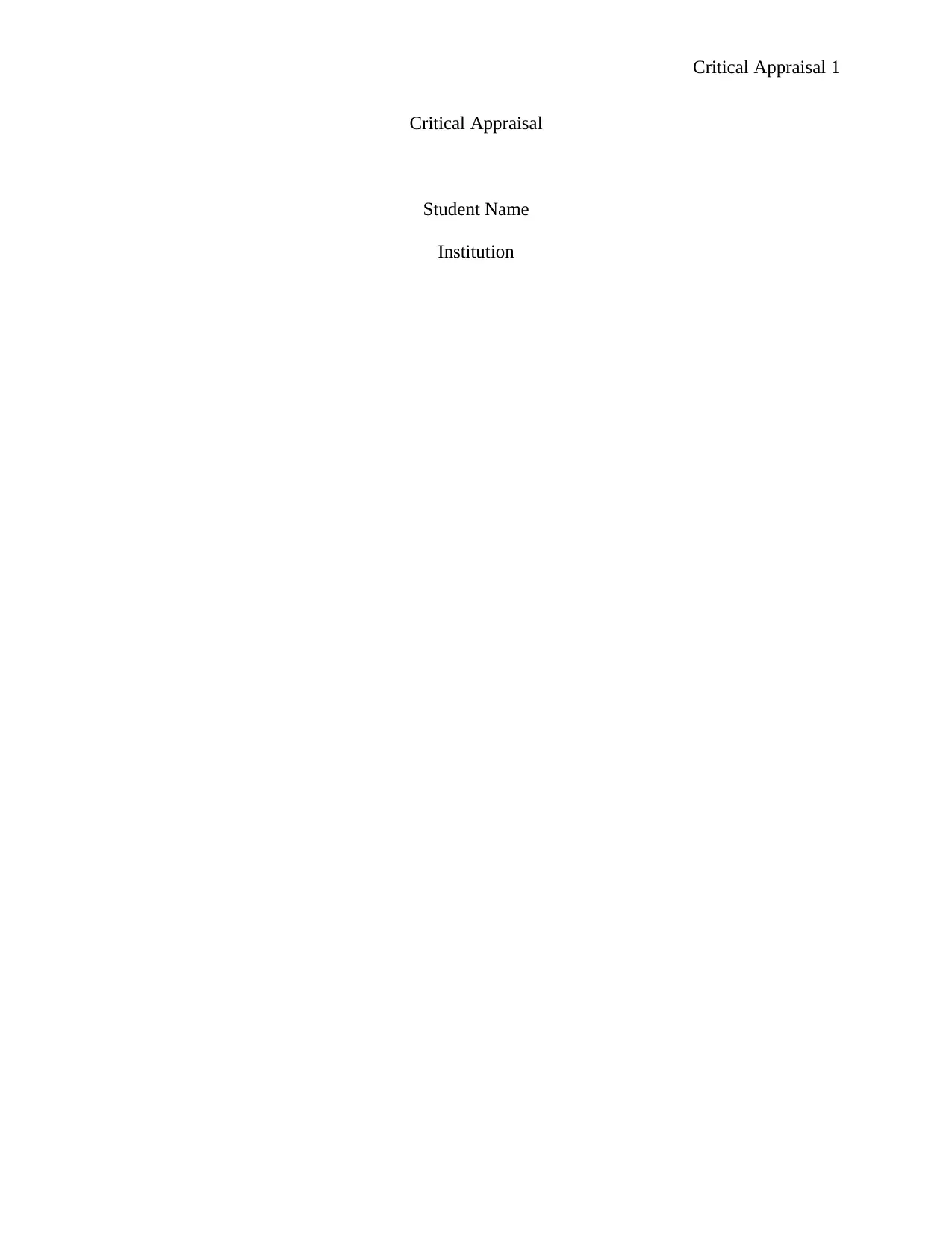
Critical Appraisal 1
Critical Appraisal
Student Name
Institution
Critical Appraisal
Student Name
Institution
Paraphrase This Document
Need a fresh take? Get an instant paraphrase of this document with our AI Paraphraser
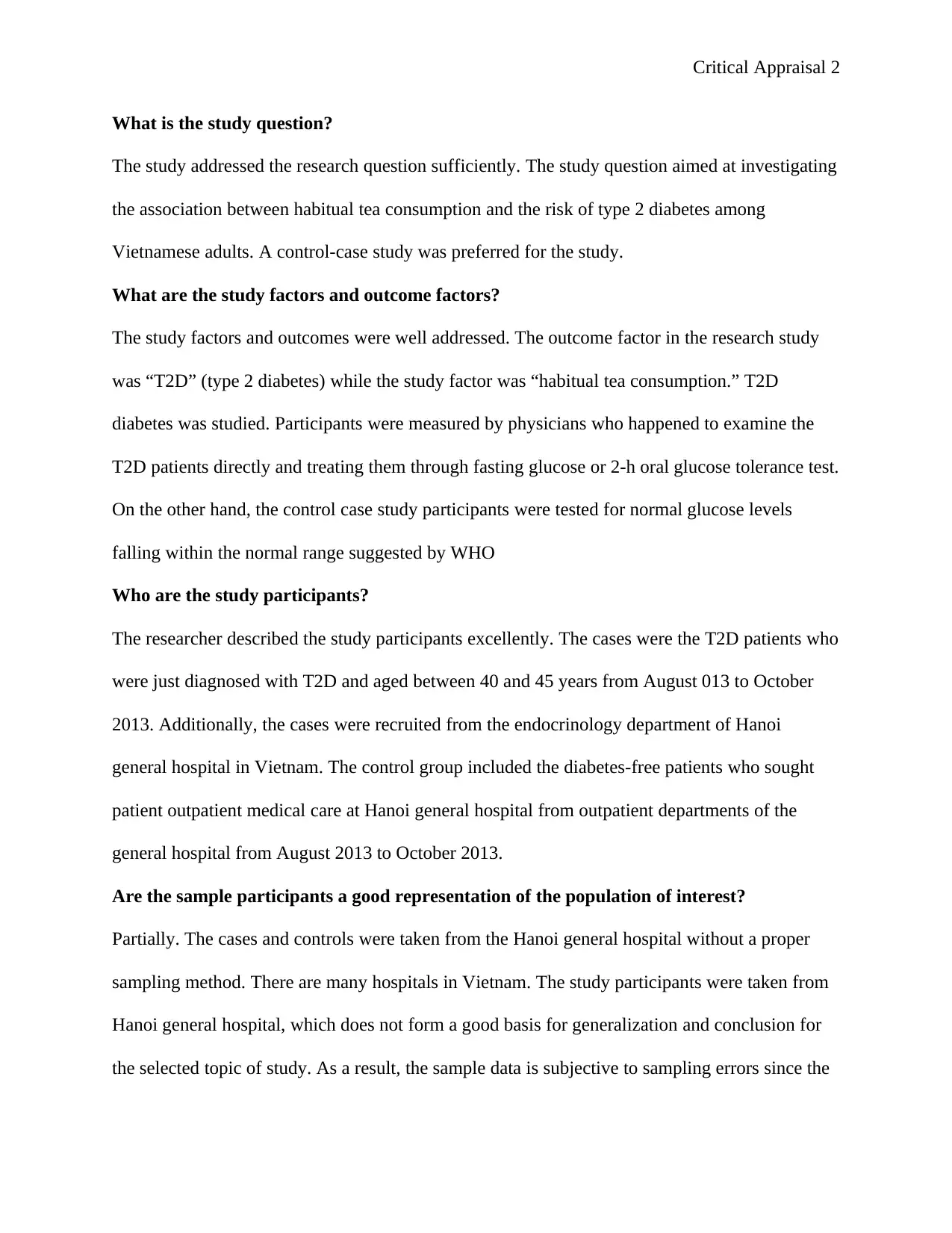
Critical Appraisal 2
What is the study question?
The study addressed the research question sufficiently. The study question aimed at investigating
the association between habitual tea consumption and the risk of type 2 diabetes among
Vietnamese adults. A control-case study was preferred for the study.
What are the study factors and outcome factors?
The study factors and outcomes were well addressed. The outcome factor in the research study
was “T2D” (type 2 diabetes) while the study factor was “habitual tea consumption.” T2D
diabetes was studied. Participants were measured by physicians who happened to examine the
T2D patients directly and treating them through fasting glucose or 2-h oral glucose tolerance test.
On the other hand, the control case study participants were tested for normal glucose levels
falling within the normal range suggested by WHO
Who are the study participants?
The researcher described the study participants excellently. The cases were the T2D patients who
were just diagnosed with T2D and aged between 40 and 45 years from August 013 to October
2013. Additionally, the cases were recruited from the endocrinology department of Hanoi
general hospital in Vietnam. The control group included the diabetes-free patients who sought
patient outpatient medical care at Hanoi general hospital from outpatient departments of the
general hospital from August 2013 to October 2013.
Are the sample participants a good representation of the population of interest?
Partially. The cases and controls were taken from the Hanoi general hospital without a proper
sampling method. There are many hospitals in Vietnam. The study participants were taken from
Hanoi general hospital, which does not form a good basis for generalization and conclusion for
the selected topic of study. As a result, the sample data is subjective to sampling errors since the
What is the study question?
The study addressed the research question sufficiently. The study question aimed at investigating
the association between habitual tea consumption and the risk of type 2 diabetes among
Vietnamese adults. A control-case study was preferred for the study.
What are the study factors and outcome factors?
The study factors and outcomes were well addressed. The outcome factor in the research study
was “T2D” (type 2 diabetes) while the study factor was “habitual tea consumption.” T2D
diabetes was studied. Participants were measured by physicians who happened to examine the
T2D patients directly and treating them through fasting glucose or 2-h oral glucose tolerance test.
On the other hand, the control case study participants were tested for normal glucose levels
falling within the normal range suggested by WHO
Who are the study participants?
The researcher described the study participants excellently. The cases were the T2D patients who
were just diagnosed with T2D and aged between 40 and 45 years from August 013 to October
2013. Additionally, the cases were recruited from the endocrinology department of Hanoi
general hospital in Vietnam. The control group included the diabetes-free patients who sought
patient outpatient medical care at Hanoi general hospital from outpatient departments of the
general hospital from August 2013 to October 2013.
Are the sample participants a good representation of the population of interest?
Partially. The cases and controls were taken from the Hanoi general hospital without a proper
sampling method. There are many hospitals in Vietnam. The study participants were taken from
Hanoi general hospital, which does not form a good basis for generalization and conclusion for
the selected topic of study. As a result, the sample data is subjective to sampling errors since the
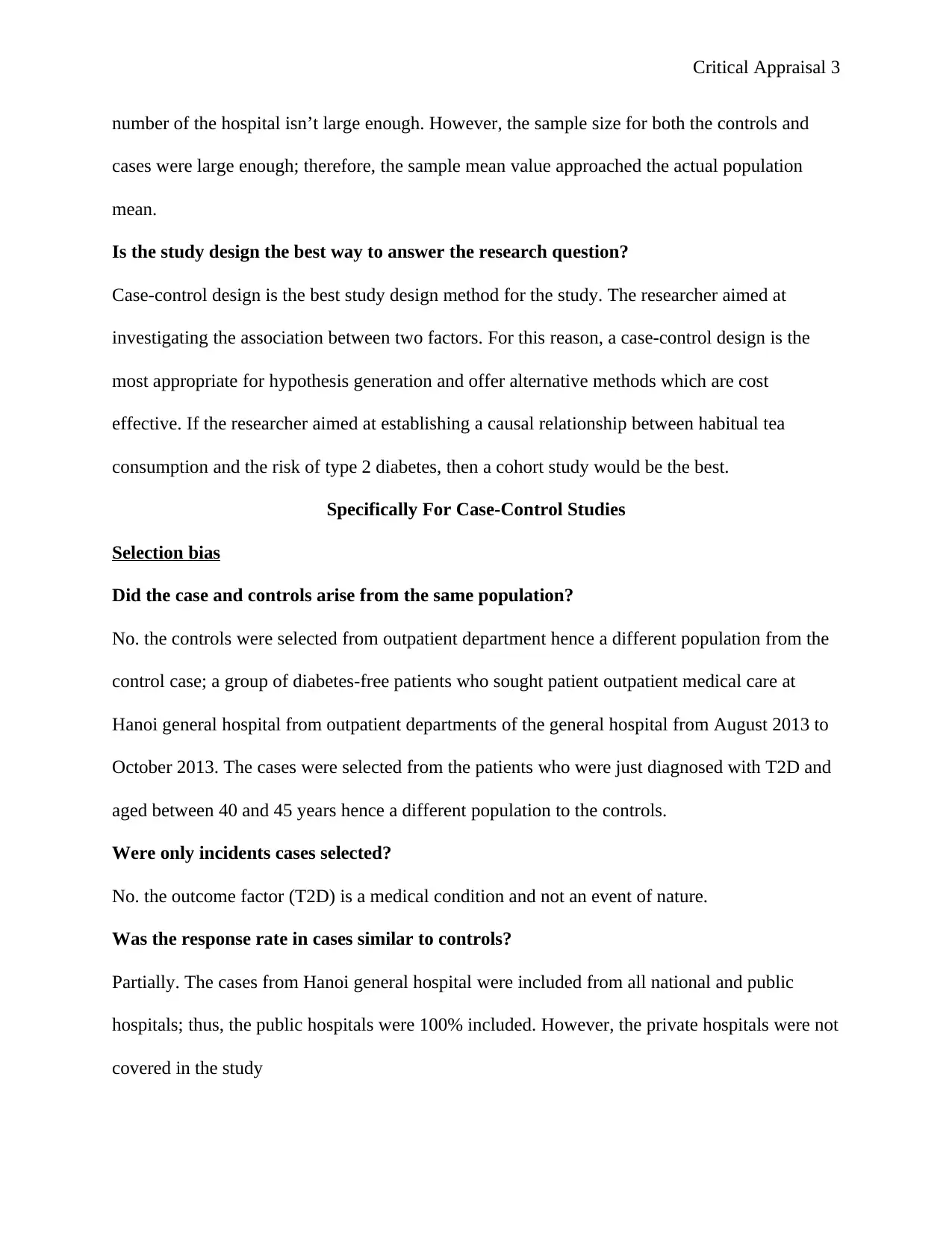
Critical Appraisal 3
number of the hospital isn’t large enough. However, the sample size for both the controls and
cases were large enough; therefore, the sample mean value approached the actual population
mean.
Is the study design the best way to answer the research question?
Case-control design is the best study design method for the study. The researcher aimed at
investigating the association between two factors. For this reason, a case-control design is the
most appropriate for hypothesis generation and offer alternative methods which are cost
effective. If the researcher aimed at establishing a causal relationship between habitual tea
consumption and the risk of type 2 diabetes, then a cohort study would be the best.
Specifically For Case-Control Studies
Selection bias
Did the case and controls arise from the same population?
No. the controls were selected from outpatient department hence a different population from the
control case; a group of diabetes-free patients who sought patient outpatient medical care at
Hanoi general hospital from outpatient departments of the general hospital from August 2013 to
October 2013. The cases were selected from the patients who were just diagnosed with T2D and
aged between 40 and 45 years hence a different population to the controls.
Were only incidents cases selected?
No. the outcome factor (T2D) is a medical condition and not an event of nature.
Was the response rate in cases similar to controls?
Partially. The cases from Hanoi general hospital were included from all national and public
hospitals; thus, the public hospitals were 100% included. However, the private hospitals were not
covered in the study
number of the hospital isn’t large enough. However, the sample size for both the controls and
cases were large enough; therefore, the sample mean value approached the actual population
mean.
Is the study design the best way to answer the research question?
Case-control design is the best study design method for the study. The researcher aimed at
investigating the association between two factors. For this reason, a case-control design is the
most appropriate for hypothesis generation and offer alternative methods which are cost
effective. If the researcher aimed at establishing a causal relationship between habitual tea
consumption and the risk of type 2 diabetes, then a cohort study would be the best.
Specifically For Case-Control Studies
Selection bias
Did the case and controls arise from the same population?
No. the controls were selected from outpatient department hence a different population from the
control case; a group of diabetes-free patients who sought patient outpatient medical care at
Hanoi general hospital from outpatient departments of the general hospital from August 2013 to
October 2013. The cases were selected from the patients who were just diagnosed with T2D and
aged between 40 and 45 years hence a different population to the controls.
Were only incidents cases selected?
No. the outcome factor (T2D) is a medical condition and not an event of nature.
Was the response rate in cases similar to controls?
Partially. The cases from Hanoi general hospital were included from all national and public
hospitals; thus, the public hospitals were 100% included. However, the private hospitals were not
covered in the study
⊘ This is a preview!⊘
Do you want full access?
Subscribe today to unlock all pages.

Trusted by 1+ million students worldwide
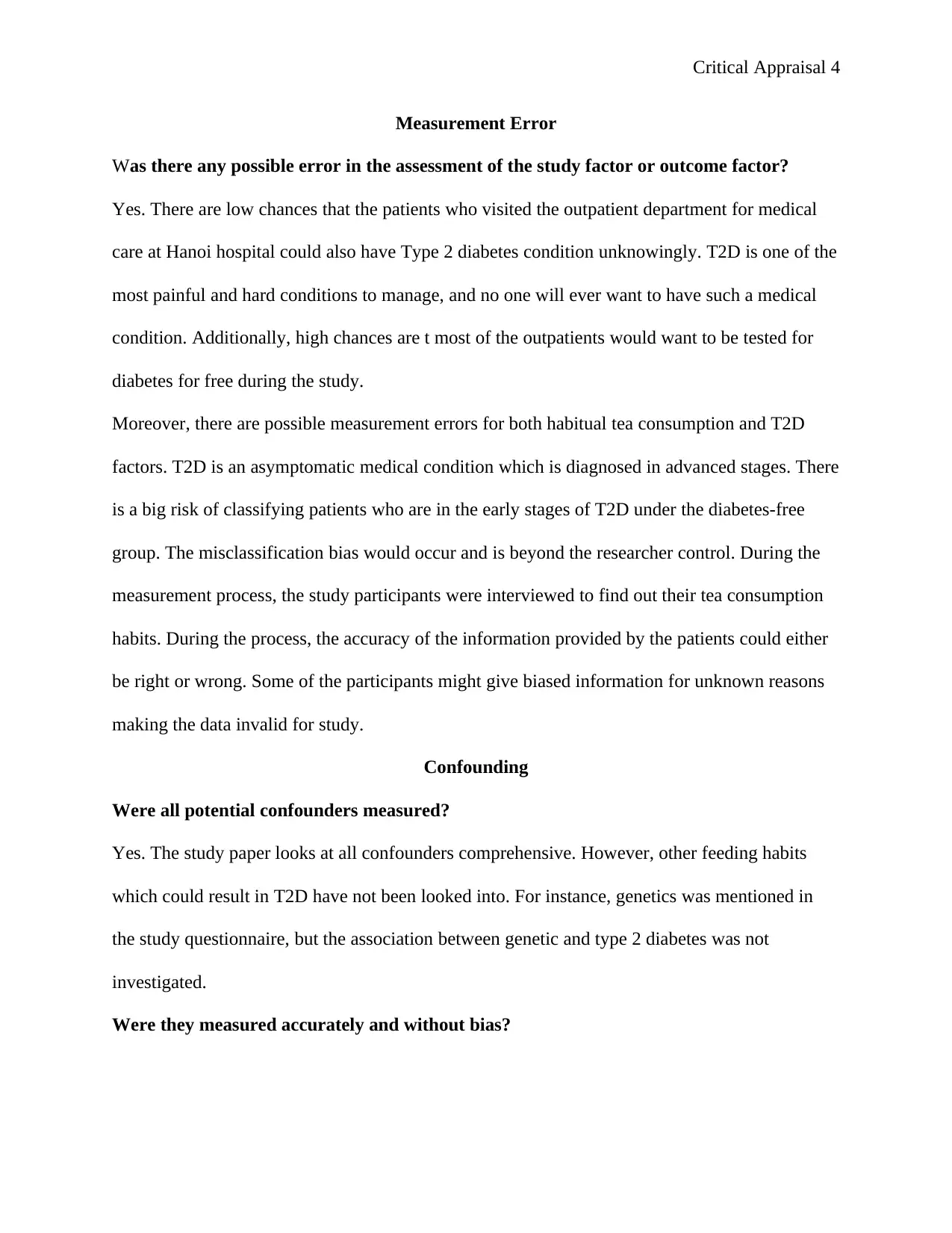
Critical Appraisal 4
Measurement Error
Was there any possible error in the assessment of the study factor or outcome factor?
Yes. There are low chances that the patients who visited the outpatient department for medical
care at Hanoi hospital could also have Type 2 diabetes condition unknowingly. T2D is one of the
most painful and hard conditions to manage, and no one will ever want to have such a medical
condition. Additionally, high chances are t most of the outpatients would want to be tested for
diabetes for free during the study.
Moreover, there are possible measurement errors for both habitual tea consumption and T2D
factors. T2D is an asymptomatic medical condition which is diagnosed in advanced stages. There
is a big risk of classifying patients who are in the early stages of T2D under the diabetes-free
group. The misclassification bias would occur and is beyond the researcher control. During the
measurement process, the study participants were interviewed to find out their tea consumption
habits. During the process, the accuracy of the information provided by the patients could either
be right or wrong. Some of the participants might give biased information for unknown reasons
making the data invalid for study.
Confounding
Were all potential confounders measured?
Yes. The study paper looks at all confounders comprehensive. However, other feeding habits
which could result in T2D have not been looked into. For instance, genetics was mentioned in
the study questionnaire, but the association between genetic and type 2 diabetes was not
investigated.
Were they measured accurately and without bias?
Measurement Error
Was there any possible error in the assessment of the study factor or outcome factor?
Yes. There are low chances that the patients who visited the outpatient department for medical
care at Hanoi hospital could also have Type 2 diabetes condition unknowingly. T2D is one of the
most painful and hard conditions to manage, and no one will ever want to have such a medical
condition. Additionally, high chances are t most of the outpatients would want to be tested for
diabetes for free during the study.
Moreover, there are possible measurement errors for both habitual tea consumption and T2D
factors. T2D is an asymptomatic medical condition which is diagnosed in advanced stages. There
is a big risk of classifying patients who are in the early stages of T2D under the diabetes-free
group. The misclassification bias would occur and is beyond the researcher control. During the
measurement process, the study participants were interviewed to find out their tea consumption
habits. During the process, the accuracy of the information provided by the patients could either
be right or wrong. Some of the participants might give biased information for unknown reasons
making the data invalid for study.
Confounding
Were all potential confounders measured?
Yes. The study paper looks at all confounders comprehensive. However, other feeding habits
which could result in T2D have not been looked into. For instance, genetics was mentioned in
the study questionnaire, but the association between genetic and type 2 diabetes was not
investigated.
Were they measured accurately and without bias?
Paraphrase This Document
Need a fresh take? Get an instant paraphrase of this document with our AI Paraphraser
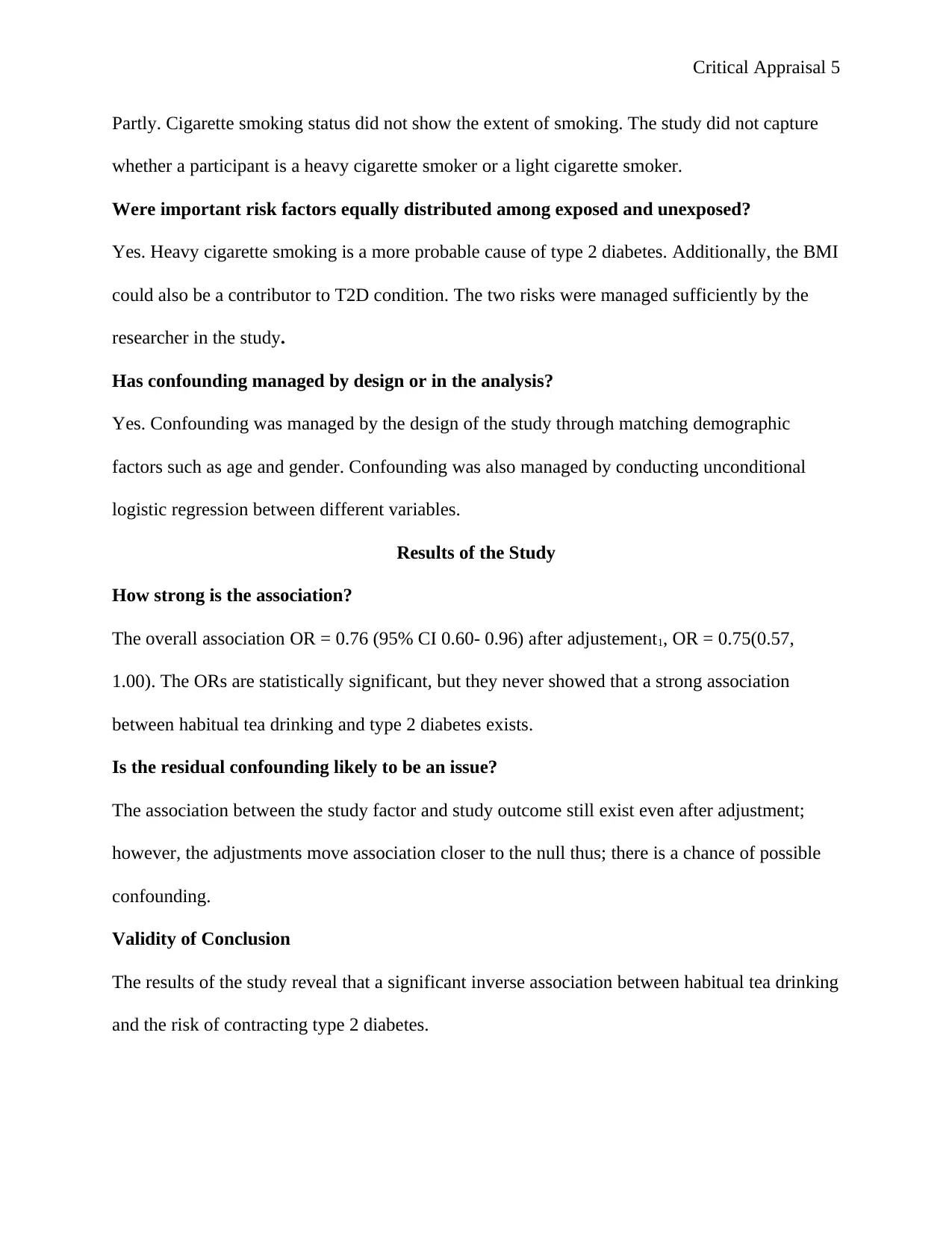
Critical Appraisal 5
Partly. Cigarette smoking status did not show the extent of smoking. The study did not capture
whether a participant is a heavy cigarette smoker or a light cigarette smoker.
Were important risk factors equally distributed among exposed and unexposed?
Yes. Heavy cigarette smoking is a more probable cause of type 2 diabetes. Additionally, the BMI
could also be a contributor to T2D condition. The two risks were managed sufficiently by the
researcher in the study.
Has confounding managed by design or in the analysis?
Yes. Confounding was managed by the design of the study through matching demographic
factors such as age and gender. Confounding was also managed by conducting unconditional
logistic regression between different variables.
Results of the Study
How strong is the association?
The overall association OR = 0.76 (95% CI 0.60- 0.96) after adjustement1, OR = 0.75(0.57,
1.00). The ORs are statistically significant, but they never showed that a strong association
between habitual tea drinking and type 2 diabetes exists.
Is the residual confounding likely to be an issue?
The association between the study factor and study outcome still exist even after adjustment;
however, the adjustments move association closer to the null thus; there is a chance of possible
confounding.
Validity of Conclusion
The results of the study reveal that a significant inverse association between habitual tea drinking
and the risk of contracting type 2 diabetes.
Partly. Cigarette smoking status did not show the extent of smoking. The study did not capture
whether a participant is a heavy cigarette smoker or a light cigarette smoker.
Were important risk factors equally distributed among exposed and unexposed?
Yes. Heavy cigarette smoking is a more probable cause of type 2 diabetes. Additionally, the BMI
could also be a contributor to T2D condition. The two risks were managed sufficiently by the
researcher in the study.
Has confounding managed by design or in the analysis?
Yes. Confounding was managed by the design of the study through matching demographic
factors such as age and gender. Confounding was also managed by conducting unconditional
logistic regression between different variables.
Results of the Study
How strong is the association?
The overall association OR = 0.76 (95% CI 0.60- 0.96) after adjustement1, OR = 0.75(0.57,
1.00). The ORs are statistically significant, but they never showed that a strong association
between habitual tea drinking and type 2 diabetes exists.
Is the residual confounding likely to be an issue?
The association between the study factor and study outcome still exist even after adjustment;
however, the adjustments move association closer to the null thus; there is a chance of possible
confounding.
Validity of Conclusion
The results of the study reveal that a significant inverse association between habitual tea drinking
and the risk of contracting type 2 diabetes.

Critical Appraisal 6
⊘ This is a preview!⊘
Do you want full access?
Subscribe today to unlock all pages.

Trusted by 1+ million students worldwide
1 out of 6
Related Documents
Your All-in-One AI-Powered Toolkit for Academic Success.
+13062052269
info@desklib.com
Available 24*7 on WhatsApp / Email
![[object Object]](/_next/static/media/star-bottom.7253800d.svg)
Unlock your academic potential
Copyright © 2020–2025 A2Z Services. All Rights Reserved. Developed and managed by ZUCOL.





